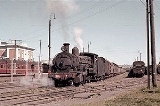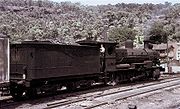
New South Wales D55 class locomotive
Encyclopedia
The D55 class was a class of steam locomotive
s operated by the New South Wales Government Railways
in Australia
. They were built with the 2-8-0 wheel arrangement.
Company of Granville for the construction of 300 K-class locomotives. Following experiments with Southern type valve gear
on an earlier class, Edward Lucy, the Chief Mechanical Engineer of the N.S.W.G.R., proposed its installation on these locomotives. The use of Southern valve gear was rare on locomotives operating outside the United States of America. The first of the class, then classified as K1353, entered traffic on 29 November, 1918. Due to financial difficulties at Clyde Engineering, the next member did not appear for a further two years. Meanwhile, the contract had been reduced to just 120 locomotives. All were in service by March, 1925 and were fitted with a Wampu type tender. The last thirty of the class were fitted with self-cleaning smokebox
es and had other modifications.
, Goulburn
, Harden
, Junee
and Cowra
. They were seldom used on western or northern lines.
With the discontent and industrial action in the coalfields following World War II
, it was decided in 1946 to convert some of the class to oil burners. The 55-class was chosen as the outside valve gear gave more room for the installation of the new equipment, which included altered firebox and smokebox. The tenders were fitted with a 2400 gallons (10,910.6 l) fuel tank. The fuel oil was injected into the firebox by a jet of steam from the locomotive boiler, the flow being controlled by the fireman. The first six locomotives converted were fitted to burn distillate which was five times the cost of coal firing, although it was hoped that reduced servicing times would offset some of that extra cost. When cheaper crude oil became available, the locomotives were again modified to allow them to burn this heavier product. This required the installation of heating coils in the tank and pre-heating adjacent to the burner to ensure complete atomisation. A further 10 locomotives were converted in 1947, followed by another 54 in 1949. As the crisis passed, the oil burning locomotives were withdrawn as they were still four times more expensive to run than the coal fired ones. 16 were converted back to coal firing. The last oil burning 55-class was 5591 which was withdrawn in February, 1959.
When cheaper crude oil became available, the locomotives were again modified to allow them to burn this heavier product. This required the installation of heating coils in the tank and pre-heating adjacent to the burner to ensure complete atomisation. A further 10 locomotives were converted in 1947, followed by another 54 in 1949. As the crisis passed, the oil burning locomotives were withdrawn as they were still four times more expensive to run than the coal fired ones. 16 were converted back to coal firing. The last oil burning 55-class was 5591 which was withdrawn in February, 1959.
A distinctive feature of the oil burning locomotives was a hinged lid provided over the chimney to protect the boiler tubes and flues from sudden cooling when the oil fire was cut off.
The last country depots to have 55-class locomotives were Goulburn and Cowra. 5597 was the last of the class in service, being attached to Enfield depot until June, 1967. Of the Standard Goods engines, the 55-class were thus the first to be retired. The Southern valve gear did not give as good steam distribution as was desirable, making the locomotives a little sluggish when hauling heavy loads, compared to the similar classes.
.
Steam locomotive
A steam locomotive is a railway locomotive that produces its power through a steam engine. These locomotives are fueled by burning some combustible material, usually coal, wood or oil, to produce steam in a boiler, which drives the steam engine...
s operated by the New South Wales Government Railways
New South Wales Government Railways
The New South Wales Government Railways was the government department that operated the New South Wales Government's railways until the establishment of the Public Transport Commission in 1972. Although later known officially as the Department of Railways, New South Wales, it was still generally...
in Australia
Australia
Australia , officially the Commonwealth of Australia, is a country in the Southern Hemisphere comprising the mainland of the Australian continent, the island of Tasmania, and numerous smaller islands in the Indian and Pacific Oceans. It is the world's sixth-largest country by total area...
. They were built with the 2-8-0 wheel arrangement.
Construction
A contract was given in 1916 to Clyde EngineeringClyde Engineering
Clyde Engineering was the name of part of the business now known as Downer EDI Rail. Clyde Engineering were involved in the construction of railway locomotives and rolling stock, as well as larger scale engineering projects on behalf of the governments of Australia...
Company of Granville for the construction of 300 K-class locomotives. Following experiments with Southern type valve gear
Southern valve gear
Southern valve gear was briefly popular on steam locomotives in the United States. It combines elements of the Walschaerts and Baker patterns.-History:...
on an earlier class, Edward Lucy, the Chief Mechanical Engineer of the N.S.W.G.R., proposed its installation on these locomotives. The use of Southern valve gear was rare on locomotives operating outside the United States of America. The first of the class, then classified as K1353, entered traffic on 29 November, 1918. Due to financial difficulties at Clyde Engineering, the next member did not appear for a further two years. Meanwhile, the contract had been reduced to just 120 locomotives. All were in service by March, 1925 and were fitted with a Wampu type tender. The last thirty of the class were fitted with self-cleaning smokebox
Smokebox
A smokebox is one of the major basic parts of a Steam locomotive exhaust system. Smoke and hot gases pass from the firebox through tubes where they pass heat to the surrounding water in the boiler. The smoke then enters the smokebox, and is exhausted to the atmosphere through the chimney .To assist...
es and had other modifications.
Operations
The members of this class spent most of their days attached to depots at EnfieldEnfield, New South Wales
Enfield is a suburb, in the Inner-West of Sydney, in the state of New South Wales, Australia. Enfield is located 13 kilometres south-west of the Sydney central business district in the local government area of Burwood Council.-History:...
, Goulburn
Goulburn, New South Wales
Goulburn is a provincial city in the Southern Tablelands of New South Wales, Australia in Goulburn Mulwaree Council Local Government Area. It is located south-west of Sydney on the Hume Highway and above sea-level. On Census night 2006, Goulburn had a population of 20,127 people...
, Harden
Harden, New South Wales
Harden-Murrumburrah is a township and community in the centre of Harden Shire and is located in the South West Slopes region of New South Wales in Australia and is adjacent to both the Canberra region of the Australian Capital Territory and the Riverina Region in the southwest area of NSW...
, Junee
Junee, New South Wales
Junee is a medium sized town in the Riverina region of New South Wales, Australia. The town's prosperity and mixed services economy is based on a combination of agriculture, rail transport, light industry and government services, and in particular correctional services...
and Cowra
Cowra, New South Wales
Cowra is a town in the Central West region of New South Wales, Australia in the Cowra Shire. It is located on the Mid-Western Highway, 317 kilometres west of Sydney on the banks of the Lachlan River at an altitude of 310 metres above sea level. At the 2006 census Cowra had a population of 8,430...
. They were seldom used on western or northern lines.
With the discontent and industrial action in the coalfields following World War II
World War II
World War II, or the Second World War , was a global conflict lasting from 1939 to 1945, involving most of the world's nations—including all of the great powers—eventually forming two opposing military alliances: the Allies and the Axis...
, it was decided in 1946 to convert some of the class to oil burners. The 55-class was chosen as the outside valve gear gave more room for the installation of the new equipment, which included altered firebox and smokebox. The tenders were fitted with a 2400 gallons (10,910.6 l) fuel tank. The fuel oil was injected into the firebox by a jet of steam from the locomotive boiler, the flow being controlled by the fireman. The first six locomotives converted were fitted to burn distillate which was five times the cost of coal firing, although it was hoped that reduced servicing times would offset some of that extra cost.

A distinctive feature of the oil burning locomotives was a hinged lid provided over the chimney to protect the boiler tubes and flues from sudden cooling when the oil fire was cut off.
The last country depots to have 55-class locomotives were Goulburn and Cowra. 5597 was the last of the class in service, being attached to Enfield depot until June, 1967. Of the Standard Goods engines, the 55-class were thus the first to be retired. The Southern valve gear did not give as good steam distribution as was desirable, making the locomotives a little sluggish when hauling heavy loads, compared to the similar classes.
Preservation
5595 is the sole survivor. It has been cosmetically restored and is displayed with a Commonwealth Turret Tender at the New South Wales Rail Transport MuseumNew South Wales Rail Transport Museum
The New South Wales Rail Transport Museum located in Thirlmere, New South Wales south-west of Sydney, is a museum dedicated to displaying former locomotives, carriages and goods wagons from the New South Wales Government Railways as well as private operations in NSW. The collection features steam,...
.

